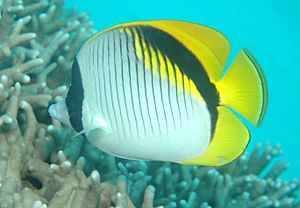Lined butterflyfish facts for kids
Quick facts for kids Lined butterflyfish |
|
|---|---|
 |
|
| Conservation status | |
| Scientific classification | |
| Genus: |
Chaetodon
|
| Species: |
lineolatus
|
| Synonyms | |
|
|
The lined butterflyfish (Chaetodon lineolatus) is a beautiful fish that lives in the ocean. It is a type of ray-finned fish and belongs to the butterflyfish family called Chaetodontidae. This fish is one of the biggest species in its group, the Chaetodon genus.
You can find the lined butterflyfish in many places. Its home stretches from the Red Sea all the way to South Africa. It also lives as far east as southern Japan and Hawaii.
Contents
About the Lined Butterflyfish
What Does It Look Like?
Lined butterflyfish can grow quite large for a butterflyfish. They can reach up to 30 centimetres (12 in) long. This makes them about the size of a dinner plate!
Their bodies are mostly white. They have thin black lines that go up and down. These lines connect to a thick black band near their tail and on their top fin. Their tail, top fin (dorsal fin), and bottom fin (anal fin) are bright yellow.
Where Do They Live?
This fish lives in many parts of the world. You can find it along the east coast of Africa, including the Red Sea. It also lives around Northern Australia, like the Coral Sea. Its home also includes the Java Sea and the Philippine Sea.
Lined butterflyfish are not super common. They are often seen swimming alone or in pairs. Sometimes, you might see them in larger groups when they are ready to lay eggs. They live in water between 2 and 50 meters deep. They prefer areas with lots of coral on reefs and in calm lagoons.
Lined Butterflyfish Life
What Do They Eat?
The lined butterflyfish enjoys a varied diet. It eats coral polyps, which are tiny animals that make up coral. It also munches on small anemones, algae, and other small invertebrates.
These fish can be quite protective of their eating spots. They are known to be territorial over the areas where they find their food.
How Long Do They Live?
A lined butterflyfish can live for a long time. Some of them can reach an age of up to ten years!
Life Cycle and Growth
Baby butterflyfish, called larvae, float around in the ocean. They can end up in different places. Some settle where adult fish live, others in areas with lots of coral. Some even land in completely different spots!
Young fish that don't start in an adult home stay where they are. They live there until they grow bigger. Once they are more than 100 mm long, they move to adult homes if they aren't there already.
Reproduction
Scientists don't know a lot about how butterflyfish lay eggs. However, it is thought that they lay their eggs near their feeding areas. This often happens around the new moon.
Lined butterflyfish often stay with the same partner for their whole lives. This is called a monogamous relationship. The male fish decides if he will stay with his mate or find a new one. This choice helps them have as many babies as possible.
These fish are social and spend time with their mate even when not laying eggs. They often live together in the same area. However, they do not take care of their young after the eggs are laid.
Who Eats Them?
Larger ocean animals like sharks, eels, and snappers eat lined butterflyfish. When their homes and feeding areas are damaged, it can make it easier for these predators to catch them.
Their Role in the Ocean
For a long time, people thought that corals and butterflyfish had a simple relationship. It was believed that coral gave the fish food and shelter, but didn't get much back.
However, we now know that lined butterflyfish and other coral-eating butterflyfish can actually affect coral growth. When they eat coral, it can change how the coral grows. This can impact the variety of life on a coral reef over time. When coral reefs are damaged, it also makes it harder for fish like the lined butterflyfish to find shelter and food. This makes them more likely to be eaten by bigger fish.
Protecting the Lined Butterflyfish
The lined butterflyfish is listed as "Least Concern" by the IUCN. This means it's not currently in danger. This is because it lives in many places and is found in protected ocean areas.
However, its biggest challenge is the loss of its home. Coral reefs are being damaged by too much development and overuse of their resources. Protecting these reefs is important for the lined butterflyfish and many other ocean creatures.
See also
 In Spanish: Pez mariposa de líneas para niños
In Spanish: Pez mariposa de líneas para niños



